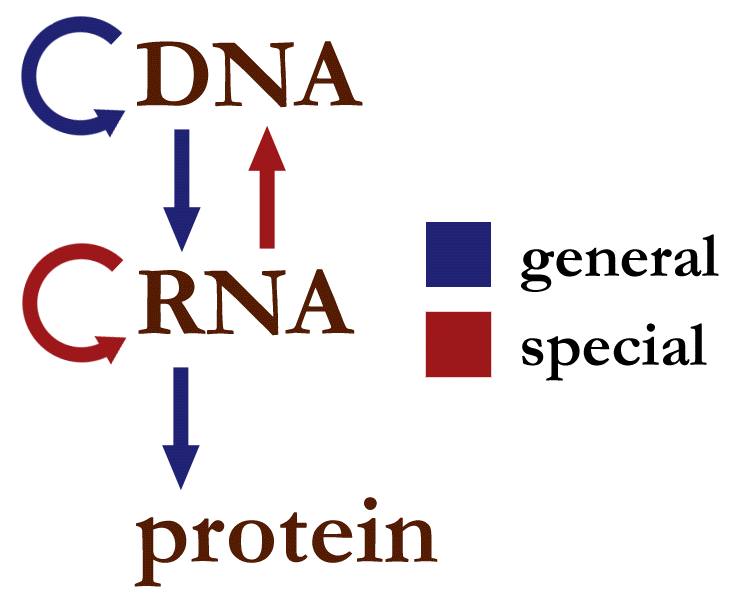 |
| Picture source: Wikimedia
The central dogma of biology is a fundamental concept in molecular biology that describes the flow of genetic information from DNA to RNA to proteins. According to the central dogma, DNA contains the genetic information that is used to produce proteins, which carry out most of the functions in a cell.
However, there are some exceptions to the central dogma. One of the main exceptions is the process of reverse transcription, which is the synthesis of DNA from an RNA template. This process occurs in some viruses, such as HIV, and in some eukaryotic cells during the process of gene expression.
Another exception to the central dogma is the process of RNA editing, which is the modification of RNA molecules after they are transcribed from DNA. RNA editing can involve the addition or deletion of nucleotides, or the substitution of one nucleotide for another. This process can change the sequence of the RNA molecule and, as a result, the protein that it encodes.
Another exception to the central dogma is the process of RNA interference (RNAi), which is a mechanism that cells use to regulate gene expression. RNAi involves the degradation of specific RNA molecules by enzymes called RNases. This process can prevent the production of proteins that are encoded by the degraded RNA, which can have important effects on cell function.
While the central dogma of biology is a fundamental concept in molecular biology, there are some exceptions to this rule. Understanding these exceptions can provide important insights into the complex processes that occur within cells.
|
वर्ग DNA replication
What Is The Difference Between Molecular Biology And Molecular Genetics
Molecular biology and molecular genetics are closely related fields of study that focus on the structure, function, and behavior of molecules within living organisms. Molecular biology is a broad field that encompasses many different sub-disciplines, including molecular genetics. Molecular genetics is a sub-discipline of molecular biology that focuses specifically on the role of genes and how they are expressed and inherited within living organisms. In other words, molecular genetics is a more specialized field within molecular biology that focuses on the genetic makeup of cells and how genes are passed down from one generation to the next.
How does qPCR work?
Quantitative polymerase chain reaction (qPCR) is a molecular biology technique that is used to amplify and measure the amount of a specific DNA or RNA sequence in a sample. It is a highly sensitive and specific method that can be used to detect and quantify the amount of a specific sequence in a sample, even when it is present at very low levels.
| Picture source: Wikimedia |
qPCR is based on the same principles as PCR (polymerase chain reaction), but it includes additional steps that allow for the quantitative measurement of the amplified DNA or RNA. In qPCR, a sample of DNA or RNA is first amplified using PCR. During the amplification process, specific fluorescent dyes or probes are added to the reaction mixture, which bind to the amplified DNA or RNA. As the amplification proceeds, the amount of fluorescent signal produced increases in proportion to the amount of amplified DNA or RNA.
After the amplification is complete, the qPCR machine measures the amount of fluorescence produced during the reaction. This allows the researcher to determine the amount of the specific DNA or RNA sequence present in the sample. Because the amount of fluorescence produced is directly proportional to the amount of amplified DNA or RNA, qPCR can be used to accurately measure the amount of a specific sequence in a sample, even when it is present at very low levels.
qPCR is an important molecular biology technique that allows researchers to quickly and accurately measure the amount of a specific DNA or RNA sequence in a sample, providing valuable insights into the molecular mechanisms of diseases and other biological processes.

